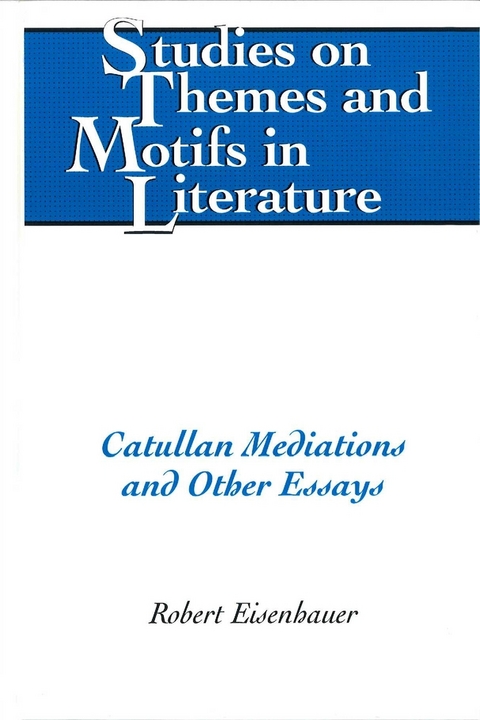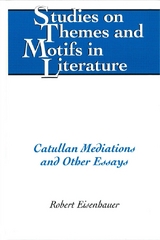Catullan Mediations and Other Essays
Seiten
2011
|
New edition
Peter Lang Publishing Inc (Verlag)
978-1-4331-1349-9 (ISBN)
Peter Lang Publishing Inc (Verlag)
978-1-4331-1349-9 (ISBN)
- Titel z.Zt. nicht lieferbar
- Versandkostenfrei innerhalb Deutschlands
- Auch auf Rechnung
- Verfügbarkeit in der Filiale vor Ort prüfen
- Artikel merken
Examining the lyrical pathology of love and abuse in a series of disseminative contexts, Catullan Mediations and Other Essays premises itself on the notion that Catullus matters to modernity the way Vergil, Cicero, or Ovid matter to earlier literary-historical periods. «‘I’ am Catullus» is seen as the Plautine parole of an alterity in ego by which the semiotic field or tesseract thickens over time in patternings both aleatory and chiastic. Mallarméan «throws» lend poetic subjectivity its aliases and alibis, inscribing the dialectic of master and slave, exposing self and other to the festive chicanery of ancient mime and neoteric mask. Putting sadistic gamesmanship into nugatory practice, the Earl of Rochester elevates libertinage to a «fine» art. Through displacing acts of translation and refiguration, Byron, Verlaine, and the Parisian fin-de-siècle, including Catulle Mendès, take divergent measure of poetic liberty, «lesbianism», and «latinerie», raising the stakes of excruciation, parody, and fictionality. Catullus’ impact on the graphic arts is felt from Alma-Tadema to Aubrey Beardsley and Cy Twombly, even as pre-Freudian psychopathology defines «classic» sexual deviancy up against new secular standards of normality.
A subsequent essay on Henry James explicates the horological aspect in fictional and autobiographical texts from The Europeans to The Golden Bowl and beyond, focusing on the shifting role of women, present, past, and future, at home and abroad, in a narrative time and space infiltrated by floating, highly perspectivized constructs, such as the ivory tower and pagoda. Noting how accouterment and significant vehicles reflect turbulence of affect, Eisenhauer tracks James’s ongoing commitment to caricature, arriving at a comparison between the aspectualizations in a Daumier illustration of the 1850s and a Coburn photograph used as a frontispiece in the New York edition (1912).
Ranging from Cindy Sherman to film noir, Jean Renoir, and TV crime shows, «Ut Pictura Cinema» argues for a filmic stasis that models itself, theoretically, on still photography and painting. Miami Vice, whose vibe is seized between Wagnerian Gesamtkunstwerk and Bergsonian durée, is seen epitomizing a uniquely American sublime Finally, using H. G. Wells, The Omega Man, and Alphaville as critical touchstones, Eisenhauer asks what can be hoped for in a technocratric world where the alpha fe/male and digital revolution threaten to render art passé in ways only partly anticipated by thinkers such as Heidegger.
A subsequent essay on Henry James explicates the horological aspect in fictional and autobiographical texts from The Europeans to The Golden Bowl and beyond, focusing on the shifting role of women, present, past, and future, at home and abroad, in a narrative time and space infiltrated by floating, highly perspectivized constructs, such as the ivory tower and pagoda. Noting how accouterment and significant vehicles reflect turbulence of affect, Eisenhauer tracks James’s ongoing commitment to caricature, arriving at a comparison between the aspectualizations in a Daumier illustration of the 1850s and a Coburn photograph used as a frontispiece in the New York edition (1912).
Ranging from Cindy Sherman to film noir, Jean Renoir, and TV crime shows, «Ut Pictura Cinema» argues for a filmic stasis that models itself, theoretically, on still photography and painting. Miami Vice, whose vibe is seized between Wagnerian Gesamtkunstwerk and Bergsonian durée, is seen epitomizing a uniquely American sublime Finally, using H. G. Wells, The Omega Man, and Alphaville as critical touchstones, Eisenhauer asks what can be hoped for in a technocratric world where the alpha fe/male and digital revolution threaten to render art passé in ways only partly anticipated by thinkers such as Heidegger.
Robert Eisenhauer received a PhD in comparative literature and German from Johns Hopkins University. Critical texts previously published include essays on Ezra Pound, Henry James, Goethe, Shelley, Truman Capote, Jean Paul, and the ode. He is the author of three published collections of poetry: The Maya Railroad (1995), Winterrules (2005) and Fugues/Cartouches (2006). A collection of his photographs from travels in the United States and abroad has appeared under the title Sequences of Light.
| Reihe/Serie | Studies on Themes and Motifs in Literature ; 107 | Studies on Themes and Motifs in Literature ; 107 |
|---|---|
| Verlagsort | New York |
| Sprache | englisch |
| Maße | 160 x 230 mm |
| Gewicht | 580 g |
| Themenwelt | Kunst / Musik / Theater ► Film / TV |
| Geisteswissenschaften ► Sprach- / Literaturwissenschaft ► Anglistik / Amerikanistik | |
| Geisteswissenschaften ► Sprach- / Literaturwissenschaft ► Latein / Altgriechisch | |
| Geisteswissenschaften ► Sprach- / Literaturwissenschaft ► Literaturwissenschaft | |
| Schlagworte | Catullus, Roman lyric, "I am Catullus," philosophical subject, translation, Byron, Verlaine, Beardsley |
| ISBN-10 | 1-4331-1349-X / 143311349X |
| ISBN-13 | 978-1-4331-1349-9 / 9781433113499 |
| Zustand | Neuware |
| Haben Sie eine Frage zum Produkt? |
Mehr entdecken
aus dem Bereich
aus dem Bereich
Poetik eines sozialen Urteils
Buch | Hardcover (2023)
De Gruyter (Verlag)
59,95 €
Buch | Softcover (2024)
belleville (Verlag)
20,00 €




